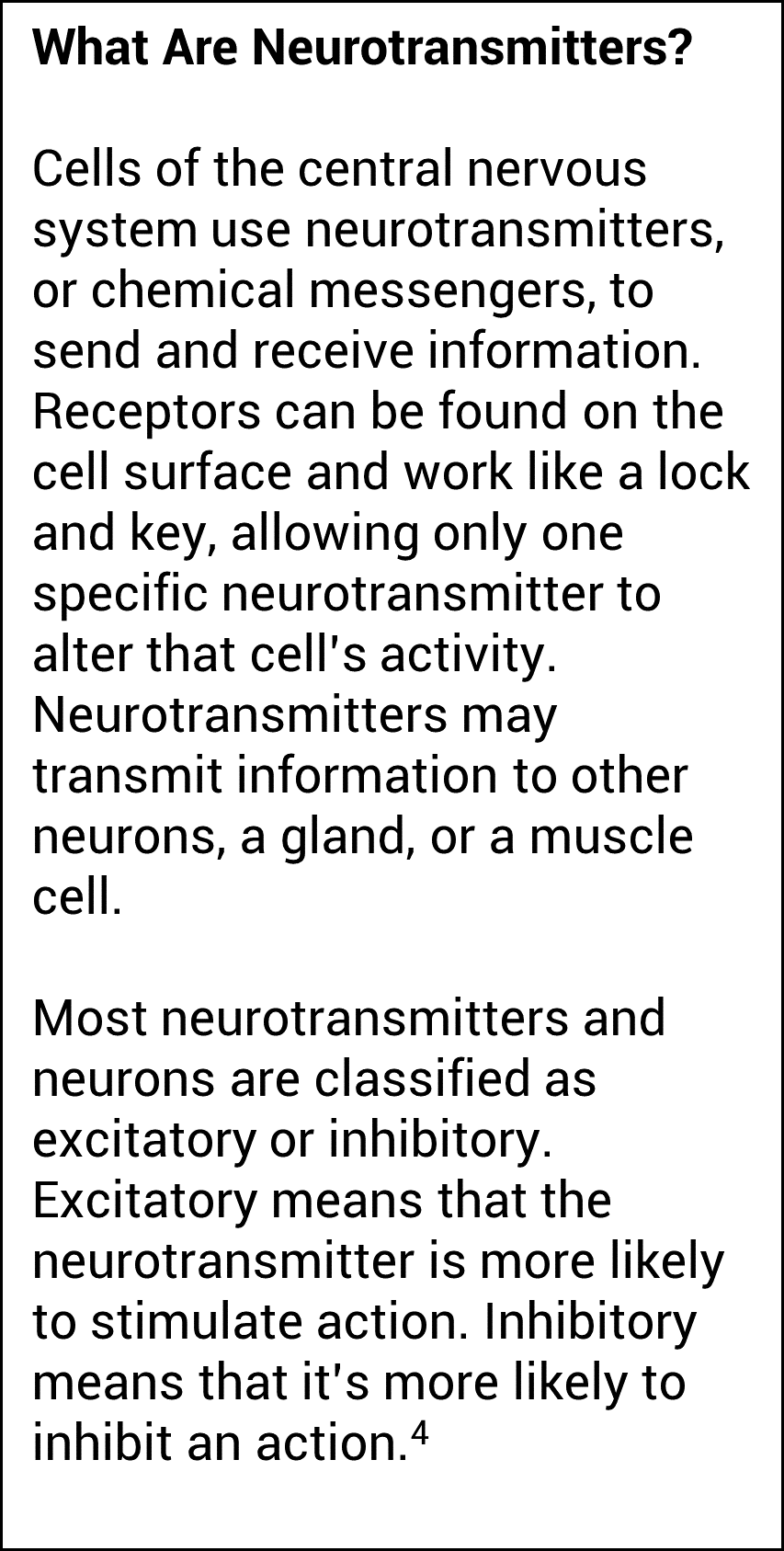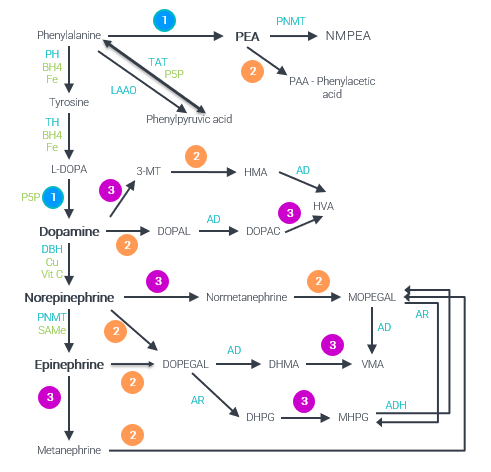Norepinephrine is an excitatory neurotransmitter that activates the hypothalamic-pituitary-adrenal (HPA) axis to help the body cope with stressful situations. It is critical for a healthy attention span, focus, concentration, and motivation.
What Is Norepinephrine and How Does It Work?
 As an excitatory neurotransmitter, norepinephrine prompts action in the neuron, gland, or cell it makes contact with. When norepinephrine binds to its complementary receptors, it can spark action across the brain and body. It is considered both a hormone and monoamine neurotransmitter. Norepinephrine is important for alertness, energy, and motivation, and plays a role in a happy mood, among many other functions.1
As an excitatory neurotransmitter, norepinephrine prompts action in the neuron, gland, or cell it makes contact with. When norepinephrine binds to its complementary receptors, it can spark action across the brain and body. It is considered both a hormone and monoamine neurotransmitter. Norepinephrine is important for alertness, energy, and motivation, and plays a role in a happy mood, among many other functions.1
As the main neurotransmitter of the sympathetic nervous system, norepinephrine’s function is to prepare the body for action or to fend off a mental or physical threat, which is why levels are lowest during sleep and highest when a person is confronted with stress or danger. Norepinephrine initiates the fight-or-flight response and is considered a stress hormone.
Is Norepinephrine Part of the HPA axis?
Norepinephrine activates the HPA axis,3 which is the body’s stress response system. The HPA axis coordinates the hypothalamus, pituitary gland, and adrenal glands, a cascade of hormones, and negative feedback loops, to turn on the fight-or-flight response or turn it off once danger has passed. It has far-reaching effects on metabolism, the immune system, and the autonomic nervous system. Either overstimulation or suppression of the HPA axis can lead to ill health.4 Norepinephrine levels are a biomarker of HPA axis activity.
How Is Norepinephrine Made?
Norepinephrine is also known as noradrenaline. It is made in the body from the amino acid phenylalanine with the help of vitamin and mineral cofactors. Phenylalanine is first converted into tyrosine, which then goes through a number of biochemical steps to produce dopamine, then norepinephrine (see Catecholamine Pathway).1
Norepinephrine is one of three catecholamines, including epinephrine and dopamine, produced in the body from phenylalanine. Norepinephrine and epinephrine are both hormones and neurotransmitters. They are released during mental or physical stress, launching the body’s fight-or-flight response.
 Catecholamine Pathway. Phenylalanine is the precursor amino acid for the catecholamines. In a series of biochemical steps, it is converted to tyrosine, L-DOPA, dopamine, and finally norepinephrine. Cofactors work with enzymes to synthesize the neurotransmitters and break them down. These include tetrahydrobiopterin (BH4), iron, copper, vitamin C, vitamin B6, magnesium, and s-adenosylmethionine (SAMe).
Catecholamine Pathway. Phenylalanine is the precursor amino acid for the catecholamines. In a series of biochemical steps, it is converted to tyrosine, L-DOPA, dopamine, and finally norepinephrine. Cofactors work with enzymes to synthesize the neurotransmitters and break them down. These include tetrahydrobiopterin (BH4), iron, copper, vitamin C, vitamin B6, magnesium, and s-adenosylmethionine (SAMe).
Enzymes and Cofactors found in Multiple Monoamine Pathways 1) Aromatic L-amino acid decarboxylase (AADC) + Vitamin B6 2) Monoamine oxidase (MAO) + Vitamin B2 3) Catechol-O-Methyltransferase (COMT) + Magnesium + S-adenosylmethionine (SAMe) Neurotransmitters and Metabolites DHPG: 3,4-dihydroxyphenylglycol, DHMA: 3,4-dihydroxymandelic acid, DOPAC: 3,4-dihydroxyphenylacetic acid, DOPAL: 3,4-dihydroxyphenylacetaldehyde, DOPEGAL: 3,4-dihydroxyphenylglycolaldehyde, HMA: 4-hydroxy-3-methoxyphenylacetaldehyde / homovanillin, HVA: homovanillic acid, MHPG: 3-methoxy-4-hydroxyphenylglycol (aka MOPEG), MOPEGAL: 3-methoxy-4-hydroxyphenylglycolaldehyde, NMPEA: N-Methylphenethylamine, VMA: vanillylmandelic acid, 3-MT: 3-methoxytyramine, Enzymes AD: aldehyde dehydrogenase, ADH: alcohol dehydrogenase, AR: aldehyde reductase, DBH: Dopamine Beta-Hydroxylase, LAAO: L-amino-acid oxidase, PH: alanine Hydroxylase, PNMT: phenylethanolamine N-methyltransferase, TAT: Tyrosine aminotransferase, TH: Tyrosine hydroxylase, Cofactors BH4: Tetrahydrobiopterin, Fe: Iron, SAMe: S-adenosylmethionine, Vit: Vitamin
Where Is Norepinephrine Found in the Body?
Norepinephrine is produced in two major regions of the body. It is made in the inner part of the adrenal glands (the adrenal medulla) where it is released directly into the bloodstream as a hormone. It is also produced in the brain. However, most of the body’s norepinephrine is synthesized in postganglionic neurons of the sympathetic nervous system, which are nerve bundles that run along either side of the spinal cord.1 Its production by the adrenal glands and the nervous system is unique and also occurs only with one other neurotransmitter (epinephrine). Parts of the body that produce norepinephrine or act on its signal, are called noradrenergic.
What Does Norepinephrine Do?
Norepinephrine works together with other hormones and neurotransmitters to influence mental and physical health. For example, norepinephrine:
Provides Energy
Norepinephrine works with adrenaline to boost heart rate and increase blood circulation. It assists in the breakdown of fat and temporarily increases blood sugar to give the body an energy spike.
Helps Us Cope with Stress
Norepinephrine levels rise during the fight-or-flight response to prepare the brain and body for action. Balanced levels are critical to handle stress effectively and to deal with life’s challenges in a calm manner.
Regulates the Sleep-Wake Cycle
Norepinephrine levels fall at night to allow for a good night’s rest and then start to rise in the morning, promoting wakefulness.
Enhances Attention, Focus, and Alertness
Another important role of norepinephrine is increased attention and focus while performing a task. It also increases the amount of time the mind retains information, especially emotionally charged memories.3 For example, norepinephrine explains why people remember where they were during the 9/11 attacks on the World Trade Center.
Mood and Emotions
When norepinephrine levels are in balance, emotions are more stable and a person’s mood is more upbeat.
What Happens When Norepinephrine Is Out of Balance?
Imbalanced norepinephrine levels are associated with a number of health concerns that impact quality of life. High norepinephrine can lead to:
- Anger
- Anxiousness and stress
- Headache
- Hot flashes
- Hyperactivity
- Increased blood pressure
- Worry or fear
- Weight management problems
Symptoms of low norepinephrine:
- Decreased mood
- Inability to stay calm
- Increased risk of substance abuse
- Lack of energy
- Poor concentration and reduced attention span
- Reduced motivation
Spikes in norepinephrine can cause euphoria, but can also lead to feelings of fear, restlessness, and blood pressure imbalances.
How Do Norepinephrine and Hormones Interact?
Norepinephrine works together with epinephrine (also known as adrenaline) and the stress hormone cortisol to regulate the stress response and activate the HPA axis. Release of norepinephrine and epinephrine are the reasons why heart rate and blood circulation increase during fight-or-flight moments. When cortisol levels are too low, may increase.
Norepinephrine also cooperates with the neurotransmitter dopamine to support working memory and attention.5 Both of these neurotransmitters affect neurons in the prefrontal cortex of the brain, which is involved in cognitive function such as attention, working memory, and decision making.5
How Does Norepinephrine Become Imbalanced?
A number of factors can disrupt norepinephrine levels or associated hormones or neurotransmitters. These factors include:
- Digestive issues. Problems digesting food can lead to impaired absorption and breakdown of the precursors and cofactors necessary for building neurotransmitters.
- Genetics. Norepinephrine gene variants can be responsible for imbalanced levels of this hormone and associated problems such as reduced attention span.6 A rare inherited disorder called genetic dopamine beta-hydroxylase deficiency stops the body from converting dopamine into norepinephrine.
- Hormonal alterations. Hormonal changes such as those that occur when using oral contraceptives can lead to alterations in the stress response and the way the body uses hormones like norepinephrine and cortisol.7
- Impaired methylation. Methylation is required to clear norepinephrine from the body by converting it to vanillylmandelic acid. Methylation helps to convert norepinephrine to epinephrine. If the methylation process is not working optimally, norepinephrine builds up in the nervous system.
- Stress. Occasional stress can deplete levels of norepinephrine. Stress increases the turnover of this neurotransmitter ultimately leading to lower levels.3
- Medications. Certain prescription drugs, such as antidepressant medications can affect brain concentrations of norepinephrine. Ritalin® elevates brain norepinephrine levels to help focus attention and block out distractions. The stimulant and recreational drug crystal methamphetamine (“meth”) can increase norepinephrine levels.
- Sleep loss. Lack of sleep can affect norepinephrine levels.8
- Poor diet. A diet lacking in the nutrients needed to make norepinephrine can affect levels of this neurotransmitter.
- Toxins. Environmental toxins, including air pollution, can impact norepinephrine concentrations.9
How Can You Identify Norepinephrine Imbalances?
Urinary neurotransmitter testing using NeuroLab® is the ideal way to pinpoint imbalances in like norepinephrine. NeuroLab® employs the gold standard in urinary neurotransmitter testing. UHPLC Triple Quadrupole Mass Spectrometry (MS) technology offers the highest level of sensitivity and specificity for neurotransmitters. This same technology has been and continues to be used at major universities and research facilities throughout the world for measuring neurotransmitter levels in patients with a variety of mental health conditions.10-14
Using a urinary neurotransmitter test from NeuroLab® makes it possible to take a snapshot of brain chemistry without the need for a blood draw. Kits can be shipped to the patient’s home, bypassing the need for a trip to the clinic, and urine can be collected in the comfort of one’s own home.
How Can We Naturally Support Norepinephrine?
It is possible to encourage healthy levels of norepinephrine through lifestyle measures, including:
- Exercise
- Getting enough sleep
- Napping following a night of little sleep
- Achieving small accomplishments
- Listening to music
- Meditation
- Eating foods rich in the amino acid building blocks and cofactors needed to make norepinephrine
- Stress reduction
Dietary supplements that include ingredients to promote a healthy stress response and that contain the necessary precursors and cofactors for neurotransmitter production can also support healthy levels of norepinephrine. These include:
- Amino acid precursors L-phenylalanine and/or L-tyrosine– These amino acid building blocks are required for producing norepinephrine.15
- B vitamins – Cofactors essential for the synthesis of norepinephrine and its precursor dopamine.
- Minerals- Iron, magnesium and copper are cofactor minerals used in the synthesis and breakdown of norepinephrine.
- Siberian ginseng (Eleutherococcus senticosus) – An adaptogen that relieves the effects of stress and fatigue.16
- L-Theanine – An ingredient found in green tea known for promoting relaxation. It can lower excessively high levels of norepinephrine.17
References
- Endocrine Society. Published 2022. https://www.endocrine.org/patient-engagement/endocrine-library/hormones-and-endocrine-function/adrenal-hormones.
- Ranjbar-Slamloo Y, Fazlali Z. Front Mol Neurosci. 2019;12:334.
- Kumar A, Rinwa P, et al. J Pharm Bioallied Sci. 2013;5(2):91-97.
- Sheng JA, Bales NJ, et al. Front Behav Neurosci. 2020;14:601939.
- Xing B, Li YC, et al. Brain Res. 2016;1641(Pt B):217-233.
- Kim BN, Kim JW, et al. J Clin Psychopharmacol. 2013;33(3):356-362.
- Nielsen SE, Segal SK, et al. Biol Psychol. 2013;92(2):257-266.
- Faraut B, Nakib S, et al. J Clin Endocrinol Metab. 2015;100(3):E416-426.
- Li H, Cai J, et al. Circulation. 2017;136(7):618-627.
- Barthelemy C, Bruneau N, et al. J Autism Dev Disord. 1988;18(4):583-591.
- Llorente AM, Voigt RG, et al. Clin Neuropsychol. 2006;20(1):133-144.
- Nichkova MI, Huisman H, et al. Anal Bioanal Chem. 2012;402(4):1593-1600.
- Grossman F, Potter WZ. Psychiatry Res. 1999;87(1):21-27.
- Linnoila M, Miller TL, et al. Archives of general psychiatry. 1984;41(7):688-692.
- Hase A, Jung SE, et al. Pharmacol Biochem Behav. 2015;133:1-6.
- Health. Published 2013. https://file.scirp.org/pdf/Health_2013092316075751.pdf.
- Eschenauer G, Sweet BV. Am J Health Syst Pharm. 2006;63(1):26, 28-30.


